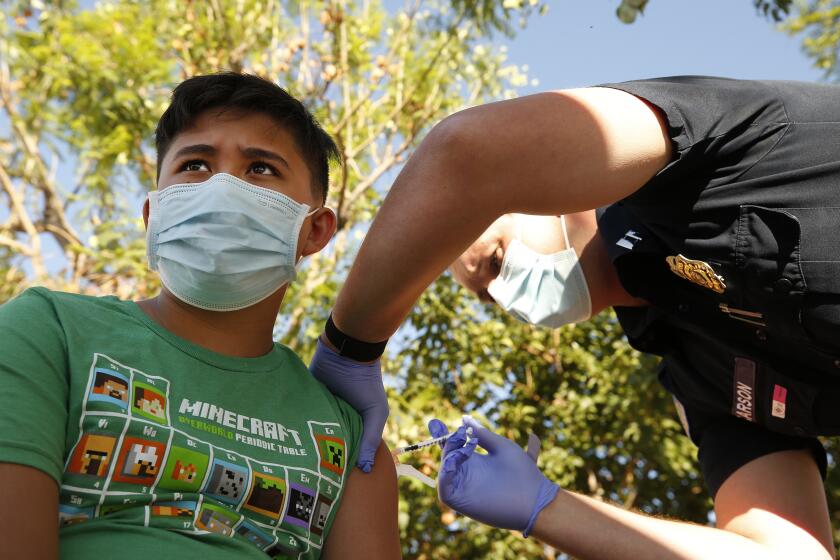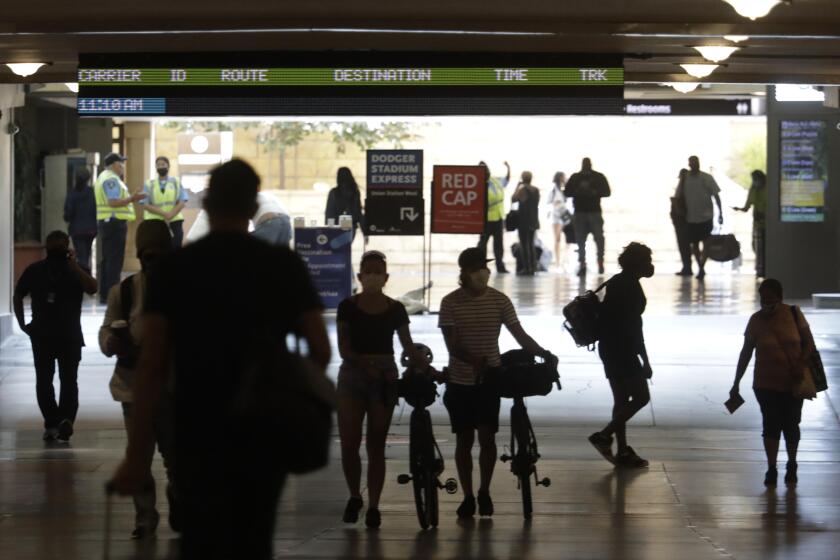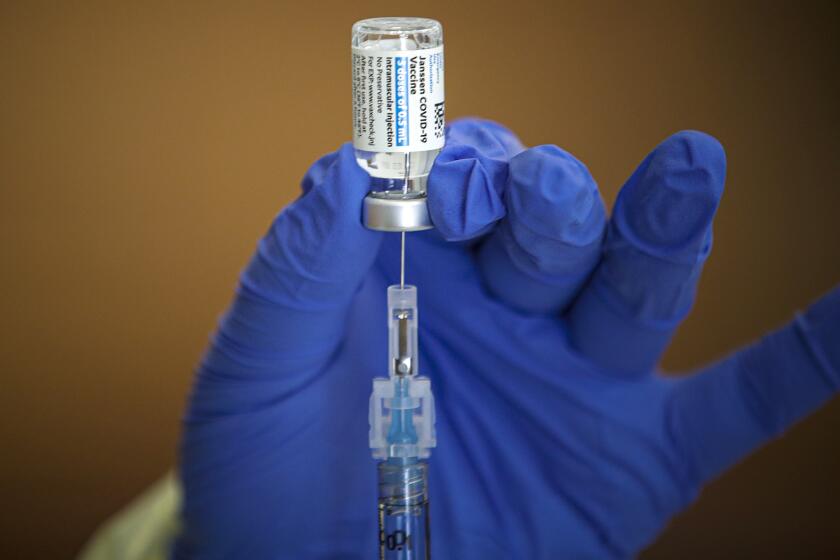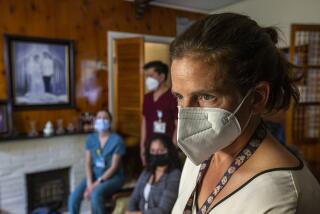‘This is not sustainable’: California hospitals filling again as Delta variant rages
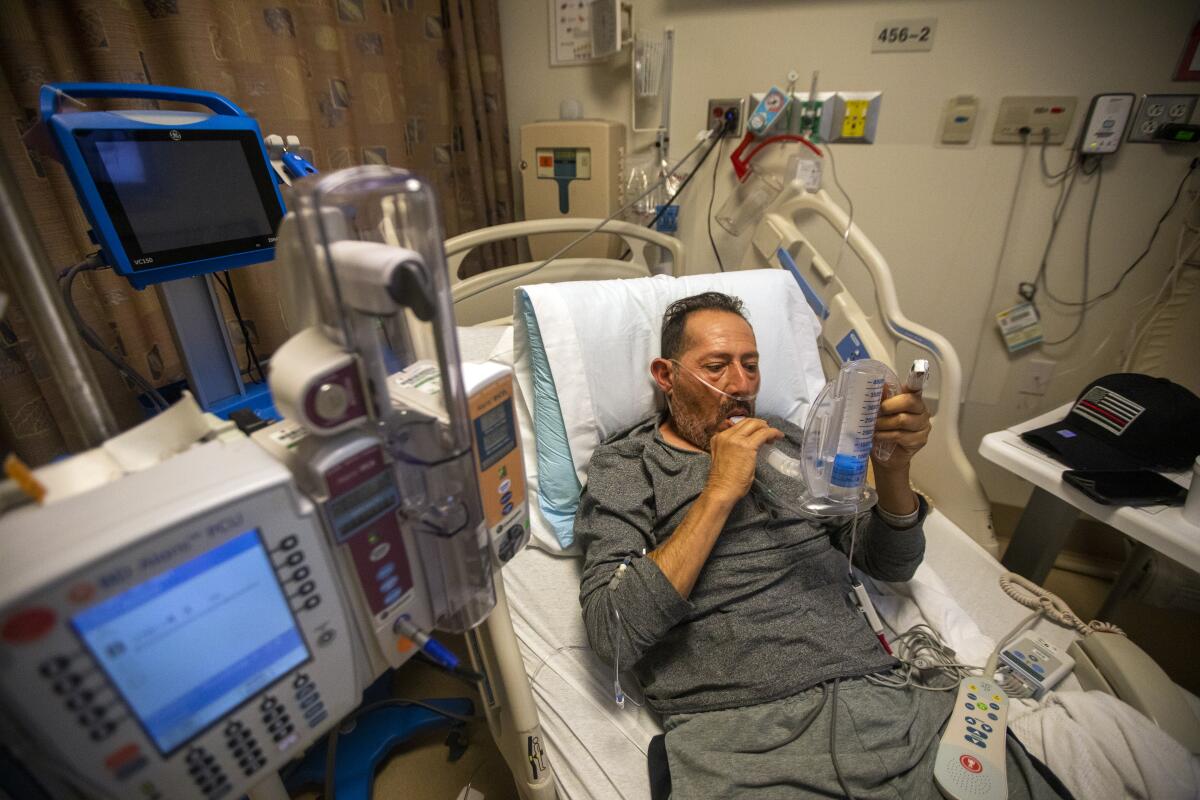
- Share via
SAN FRANCISCO — Officials across California are sounding new alarms about a significant spike in COVID-19 hospitalizations amid a surge fueled by the Delta variant of the coronavirus.
While the numbers are still well below the levels seen during the fall and winter — when some hospitals were pushed to their breaking points — the rise is still alarming for a healthcare system weary and worn thin after almost a year and a half on the pandemic’s front lines.
Many of the state’s most populous areas have seen their COVID-19 hospitalizations double over the span of a few weeks.
And overall, California has seen its total number of hospitalized coronavirus-positive patients swell from 2,981 on July 25 to 5,973 as of Sunday.
COVID-19 hospitalizations have essentially doubled across much of California over the past two weeks — a troubling trend officials say illustrates the pandemic’s continued potency amid an ongoing surge in infections.
Regional breakdown:
Los Angeles County
In L.A. County, hospitalizations have doubled in the last 15 days, from 745 on July 24 to 1,503 on Sunday — the region’s worst number since the waning days of the devastating fall and winter surge.
Orange County
Between July 27 and Thursday, hospitalizations in Orange County jumped from 215 to 453 — more than doubling in just over a week. The number of COVID-19 patients rose to 463 on Saturday, the worst since late February, before falling slightly to 453 on Sunday.
Elsewhere in Southern California
Hospitalizations shot up from 239 on July 26 to 484 on Sunday in San Diego County, and have also at least doubled over the last 15 days in Riverside, San Bernardino and Ventura counties.
This week, leaders of the city of Los Angeles city as well as county supervisors will consider vaccination mandates for a wide swath of public places.
Bay area
Across the nine-county San Francisco Bay Area, there were a combined 436 COVID-19 patients hospitalized on July 22. By Sunday, there were 881.
Sacramento
In Sacramento County, hospitalizations doubled from 148 on July 24 to 315 on Sunday.
Fresno
In Fresno County, the number of hospitalized COVID-19 patients doubled from 100 on July 28 to 214 on Sunday.
According to a Times analysis, 14 California counties are reporting per capita rates of more than 20 COVID-19 hospitalized patients for every 100,000 residents — as bad as the rate of hospitalized flu patients during the peak of the flu season.
The hardest-hit counties are in and around the Central Valley, including Sacramento, Fresno, San Joaquin, Stanislaus, Solano, Placer, Butte, Kings, Nevada, Yuba, Tuolumne and Amador counties, as well as Lake and Del Norte counties in Northern California.
Unvaccinated
Data continue to show that the vast majority of those getting infected by, and ultimately hospitalized with, COVID-19 are uninoculated.
For the week of July 31, the average coronavirus case rate among unvaccinated Californians was 33 per 100,000 residents per day, nearly five times the comparable rate of vaccinated individuals.
As of last week, the risk of being hospitalized for COVID-19 in L.A. County was 19 times higher among those who are not fully vaccinated than it is for those who are, according to county Public Health Director Barbara Ferrer.
Health officials say they’re largely unnecessary and the primary focus should be getting the unvaccinated to roll up their sleeves.
And in Orange County, Supervisor Katrina Foley said Monday that 90% of COVID-19 patients who have been hospitalized have been unvaccinated.
“Very few of us are going to get out [of the pandemic] without either getting COVID illness or getting vaccinated,” said Dr. Matthew Zahn, Orange County’s deputy health officer and a pediatric infectious disease expert. “And, clearly, getting vaccinated is the safer, healthier way for us to go.”
Over 90% of the county’s coronavirus cases that were later analyzed for genomic sequencing have been identified as being caused by the ultra-contagious Delta variant, he added during a briefing Monday.
Delta, he continued, “is the reason that we are seeing an increase in the numbers of cases overall.”
Hospitals
In a letter last week, Dr. Carl Schultz, emergency medical services director for the Orange County Health Care Agency, urged the region’s hospitals to take steps to reduce ambulance patient offload times — as well as the number of hours they’re spending on diversion, when ambulances are redirected to other medical facilities.
“This is not sustainable,” he wrote in the letter Wednesday. “We have not witnessed increases in ambulance-related numbers of this magnitude since the worst days of the second surge in December of 2020 and January of 2021.”
As of several days ago, Orange County was reporting that it was taking 44 minutes to offload 90% of its ambulance patients into hospitals. Normally, it takes around 25 minutes to offload an ambulance patient.
The offload time, however, has improved more recently, and was around 32 minutes Sunday.
“We’re still in an area where I’m worried, but we’re not in a crisis right now,” Schultz said during a news briefing Monday.
More to Read
Sign up for Essential California
The most important California stories and recommendations in your inbox every morning.
You may occasionally receive promotional content from the Los Angeles Times.
